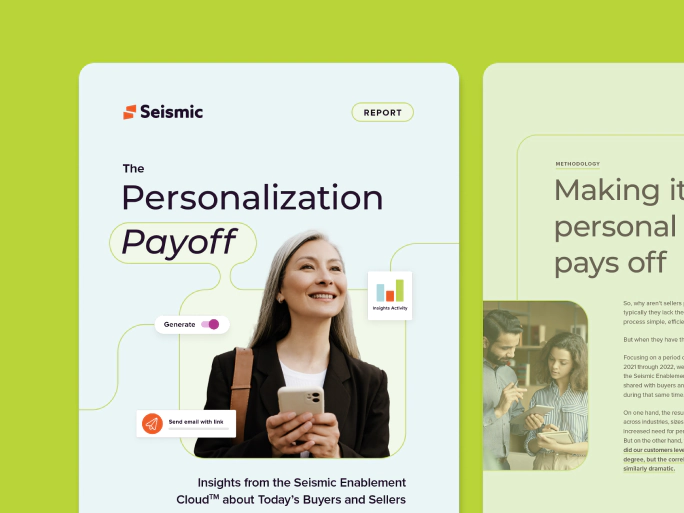What does content personalization mean?
Content personalization tailors brand messaging and communications to reflect the unique needs and characteristics of individual buyers. This includes content that is relevant to specific stages of the buyer’s journey, or it may go a step further with hyper-personalized messaging that acknowledges the buyer’s particular business needs or past behaviors. With customer expectations higher than ever, the use of personalized content creates a unique and highly-targeted experience that is key to the success of every deal.
Why is personalized content important?
Buyer engagement and the sales cycle have drastically evolved over the past few years. Modern buyers are more informed and have had an average of 27 information-gathering sessions before they ever speak to a sales rep. When buyers finally interact with a seller, they expect the rep to provide tailored and hyper-relevant information. In fact, McKinsey found that more than 70% of today’s buyers expect companies to deliver a personalized experience, and 76% will move to another organization if they’re unhappy with their experience.
So while customers certainly expect it, it’s also proven to be more effective. Personalization cuts through the clutter, allowing brands to get the attention of buyers who are constantly bombarded with marketing and advertising messages. We’ve seen firsthand how personalization empowers sellers to effectively engage with buyers and customers. Our report, The Personalization Payoff, found that more companies are sending personalized content than ever before. This includes an 89% increase in personalized content sent by companies with fewer than 1,500 employees over a one-year period alone. These same companies saw their efforts pay off, with buyer engagement increasing by 57%, underlining the power of tailored content to generate higher conversion.
The Personalization Payoff

Challenges of delivering a personalized experience
While personalization is critical to buyer engagement, both customer-facing and marketing teams encounter unique operational challenges in executing a successful approach. Additionally, 63% of GTM leaders say that the content their teams use is not personalized enough for customers.
Customer-facing teams
Sellers are in frequent communication with prospects and need content to provide personalized and helpful content needed to close a deal. Often, the overall lack of time and/or a clear understanding of what content is available and approved causes sellers to reuse old decks and collateral. Or, they may even resort to creating their own content, which may not be compliant or consistent with the latest messaging.
Marketing teams
Marketing’s goal is to produce engaging content that is accessible to sales. Catering to every individual request for content isn’t realistic, and 42% of B2B marketers say that their marketing efforts aren’t fully personalized. Building systems to create content at scale and finding the right delivery methods are two common roadblocks that must be solved to support a personalized content program.
Did you know?
Companies that prioritize personalization experience a 57% increase in buyer engagement.
Content personalization strategies and tips
Let’s explore three key strategies that support marketing and sales teams in addressing these challenges and delivering exceptional personalized content:
1. Know your buyer
At the heart of personalization is a deep understanding of the buyer. Building a research phase into your content personalization strategy will ensure that teams are aligned on buyer needs and preferences, so that the content can be as relevant and relatable as possible. Marketing can support this by building out personas and a customer journey map, while sales can provide perspectives from their more frequent communications with prospects.
2. Make messaging relevant
Once teams have a strong understanding of the buyer, it’s time to create content. It’s helpful to segment audiences into groups based on defining characteristics, like demographics, company size or job title, or even past engagement with your brand. Brainstorm what messages will be most effective for each group and the types of content that would most likely be consumed. The more data points you have on the customer, the more relevant you can be.
3. Curate content carefully
Discoverability is a key piece of the puzzle. As the volume of content grows, marketing teams will need to find a way to manage the library of content, organized by segment or buyer’s stage, and provide easy access for customer-facing teams. It will also be critical to keep content up to date over time and remove or add new assets as needed to support the business.
Effective personalized content examples
It can be challenging to know where to start with content personalization. Here are a few examples to help you tailor your messages to the your buyers:
- Incorporate the buyer’s logo or brand elements in pitch decks or proposals.
- Reference the buyer’s past interactions or purchases to offer relevant recommendations or insights, reinforcing their connection with the brand.
- Tailor messaging based on the buyer’s role. — For example, use technical language for an IT decision-maker, or share high-level business implications and data to show a return on investment for a CFO.
- Implement dynamic content in emails or on your site that change based on user behavior.
- Use case studies and testimonials relevant to the buyer’s industry or role.
The value of enablement tools for content personalization
Sales enablement tools are powerful resources that companies can use to generate personalized content and manage it effectively. Recently, Seismic found that sellers at companies without an enablement tool spend an average of 10 hours per week tracking down and revising content. Here are a few ways enablement tools can reduce this workload and boost productivity:
Produce content at scale
Marketing teams often struggle to create enough content to serve the entire sales organization’s needs, let alone with the level of personalization required for today’s buyers. Content personalization tools store and organize existing content and allow easy edits and updates to adjust for different segments and use cases. They essentially function as a vast digital library that allows for easy discovery.
Personalize content
Enablement tools often include dynamic content features that allow for the fast personalization of content based on buyer characteristics. In many cases, sellers can do this without the help of marketing and pull personalized content into different formats, such as PowerPoint presentations or Google Slides. Putting more power into the hands of reps allows them to focus on selling, not searching for content, and reduces the burden on the marketing team.
Measure effectiveness
Content personalization tools provide organizations with quantifiable data on their content performance and usage. For example, these tools can track everything from, click-through rates on a specific piece of content to the time the buyer spent reading the content. They also help attribute collateral to conversion and buyer decisions down the road. This wealth of data and insights helps organizations fine-tune their enablement strategy and build a plan for developing the most engaging content.
Save reps 360 hours per year
Ready to make your content stand out?
The Seismic Enablement Cloud™ features solutions that make it easy for go-to-market organizations to build content at scale and harness the power of personalization. These tools help marketing teams streamline content delivery so it’s more efficient and impactful. As a result, enablement teams can ensure the right messages and content is delivered to sellers precisely when they need it. And with our robust self-service tools, sellers can quickly and easily create personalized content that resonates with buyers and stands out from competitors. Ready to learn more? Read how Salesloft experienced a 35% increase in win rates after implementing Seismic. Or, get a demo where you can get a deeper dive on our sales content management and automation features.



